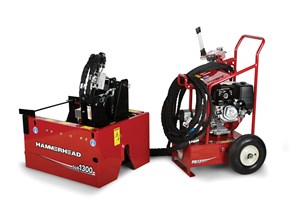March 2020 Vol. 75 No. 3
First Look
HammerHead Unveils Small-Pipe Extractor, Installation Systems
Jeff Griffin, Senior Editor
HammerHead Trenchless is introducing a small-pipe extractor for removing old steel gas service lines and installing new plastic pipe in one step.
The patented HammerHead SLX1300 was featured at the 2020 ConExpo Show and will be available from North American Ditch Witch dealers in May.
“The product was developed to fill the specific need of the gas industry to extract welded steel pipe and install MDPE or HDPE in its place,” said Mark Randa, HammerHead research and development senior design team manager. “The SLX1300 also could extract non-gas steel pipe, but the tensile strength of MDPE and HDPE is not sufficient to remove those types of pipe by this process.”
Randa said the product is undergoing field trials on pipe made of other materials, such as copper, which have been successful.
“We anticipate the use of this technology for larger copper rehabilitation projects in the water market, pending completion of final testing,” he said.
The SLX1300 package can be transported in a pickup truck.
Extraction
To make an extraction-installation, the 660-pound extractor unit requires a pit of approximately 4 feet by 4 feet, which is dug about 9 inches deeper than where the service line to be replaced connects to the main. In order to minimize the footprint of the unit in the pit, the power source for hydraulics (a 13-horsepower engine) and control station sit outside the pit linked with two quick-connect hoses. It is unnecessary for the operator to be in the pit.
Randa said after the service line to be replaced has been disconnected from the main and purged, the extractor is lowered – usually with a compact excavator – into the excavation over the stub of pipe protruding from the face of the excavation.
“A second excavation, usually at the riser, is made where the service line is disconnected from the meter,” he continued. “A tap-like tool is threaded into the inner end of the steel pipe, and it is coupled to the new plastic pipe to be installed. The three-lever control station on the surface is connected to the downhole unit. The hydraulic power is used to close a set of jaws on the protruding stub of pipe, crushing it between them.
“The pull cylinders, with 13.3 tons of pullback force, are then engaged, extracting the pipe that is clamped within the jaws. As the steel is extracted, the new plastic is pulled in behind it.”
The cycle repeats clamping and extracting 10 inches per cycle.
If space is sufficient, the unit is capable of extracting pipe in a single length. But in most cases, a small excavation is preferred, limiting the length of pipe that can be extracted.
“For this,” said Randa, “a shearing device is built into the machine which can be engaged as desired to cut the extracted pipe into segments that will fit in the excavation and can be easily managed.”
Unique
Randa notes there are other trenchless methods for installing new services, but the old pipe is not removed in the process. Leaving old pipe in the ground can cause potential locating issues in the future and can be an expense when easements are leased by the owner.
According to Randa, there is another small-diameter pipe pulling machine on the market primarily used for water pipes, but it requires an excavator or other machine to power hydraulics, and extracted pipe
is handed differently.
“The SLX1300,” Randa concludes, “is another example of HammerHead’s Same Path Technology that installs new product on the same path as an existing line, which minimizes risk to surrounding utilities
and allows for upsizing.”
The HammerHead Trenchless product line includes piercing tools, pipe rammers, winches, pipe bursting equipment, reinstatement and cleaning tools, rock hammers, and lateral and mainline cured-in-place-pipe (CIPP) lining equipment. •
FOR MORE INFORMATION:
HammerHead, (800) 331-6653, hammerheadtrenchless.com





Comments